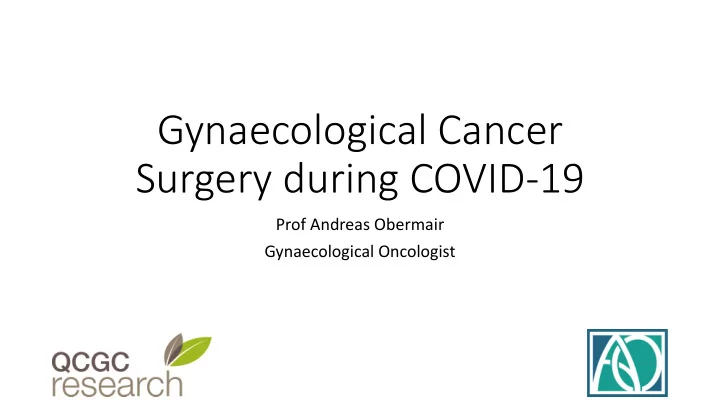

Gynaecological Cancer Surgery during COVID-19 Prof Andreas Obermair Gynaecological Oncologist
Rule #1 Your gynaecological oncologist will be available throughout the crisis Some aspects of treatment and communication will need to adjust
Australian Government directives (25 March) • Cancel all elective surgery Cat 3 (and non-urgent Cat 2) • Cancer-related measures (Cat 1,urgent Cat 2) are not affected • Diagnose cancer • Investigations for vaginal bleeding • Surgery for pelvic masses • Medical imaging • Treat cancer (surgery, chemo, radiation treatment) as scheduled • Treat conditions that could worsen if we would wait • Investigations or treatment of recurrence • Follow-Up
The role of surgery Important for patients with • Uterine cancer • Ovarian cancer • Cervical cancer • Vulval cancer
What we know … 1. Healthcare resources will be limited (operating theatres, intensive care beds, ward beds, doctors will be attending to urgent COVID-19 patients) 2. Surgery is an important lifesaving part in gynaecological cancer treatment 3. Patients with suspected or proven gynaecological cancer and who are COVID-19 negative will be treated as usual pending available resources 4. Medical imaging, pathology providers are available to patients locally, will remain open and may be used more often in the next few weeks 5. Telehealth covers many aspects of follow up (save travel)
COVID-19 1. COVID-19 (symptomatic) patients have higher surgical complication rates 2. COVID-19 patients can infect healthcare workers who could get killed • IMPORTANT that patient sick with COVID-19 prioritize COVID over gyn cancer
Uterine cancer • Surgical treatment • Alternative option #1: Medically compromised patients can have intrauterine Progestins (delay 6 mths OK) • Alternative option #2: Delay <6-8 weeks for intermediate and high-risk uterine cancers • If comorbidities are of concern: Treat them first • Follow up: Travel may be difficult. Involve Telehealth, symptoms (bleeding, pain) need to be investigated; medical imaging, bloods. Local GP for investigations.
Ovarian cancer • Symptoms should be evaluated (bloating, fullness, bowel symptoms): Tumour markers, medical imaging (US, CT, PET/CT) arranged by GP • Patients need to be seen and examined by gynaecological oncologist (ideally within 1 week to assure patient & family). • Some patients require surgery (laparoscopic or open) – avoid surgery that requires ICU admission (chemo instead). If surgery: within 4 weeks. • Some patients need upfront chemotherapy with investigations after 3 cycles. Start within 4 weeks. • Follow up: Involve Telehealth, symptoms need to be investigated; medical imaging, CA 125 monitoring. Limited role of physical examination. • Treatment of recurrence: Needs to be determined individually
Cervical cancer • Very early cervical cancer (stage 1a) • Cone biopsy or simple hysterectomy • Can be delayed for 8 weeks • Localized cervical cancer (stage 1b) • Radical hysterectomy + pelvic lymph nodes • To be treated < 4 weeks • Locally advanced or advanced cervical cancer (stage 2+) • Chemo-Radiation treatment • Will not take up resources that are needed otherwise • To be treated < 4 weeks • Follow up: Travel may be difficult. Involve Telehealth, medical imaging and local GP for investigations (PAP smear).
Vulval cancer • Vulval tumour (proximity of tumour to urethra, clitoris or anus) • Groin nodes Surgery within 4 weeks (advanced cancers for chemoradiation treatment) Delay of longer may result in disease progression (cancer may become much more difficult to treat) Follow up: Self-examination. Physical examination infeasible through Telehealth. ? See GP. Ultrasound of groins is possible remotely.
Summary • Patients with confirmed COVID-19 and pneumonia • Avoid surgery (unless for life threatening reasons) • Isolate or have treatment for COVID • Patients who don’t have COVID-19 • As usual as possible • Symptoms are evaluated (vaginal bleeding, pelvic masses) to exclude or confirm cancer • Surgery will continue to be offered for patients with suspected or proven gynaecological cancer (pending availability of healthcare resources) • Follow up should continue but should avoid unnecessary face to face consultations if possible; Telehealth is available.
Questions 1. Palliative care Likely will be reduced (publicly); Reactivated once crisis is over Stay connected Centre for Gynaecological Cancer Research Your gynaecological cancer treatment team
Recommend
More recommend